Alba Mineral Resources (ALBA ) has commenced its maiden drilling operations at the Amitsoq Graphite Project in southern Greenland.
Maiden Drilling Campaign
Alba’s operating subsidiary, Obsidian Mining Limited (“Obsidian”), has now commenced a 15-hole, 1,700m diamond core drilling programme with the aim of establishing a maiden Mineral Resource.
Figure 1: Amitsoq Graphite Project in southern Greenland, showing Amitsoq Island graphite deposit to north (site of former graphite mine) and Kalaaq Discovery to south
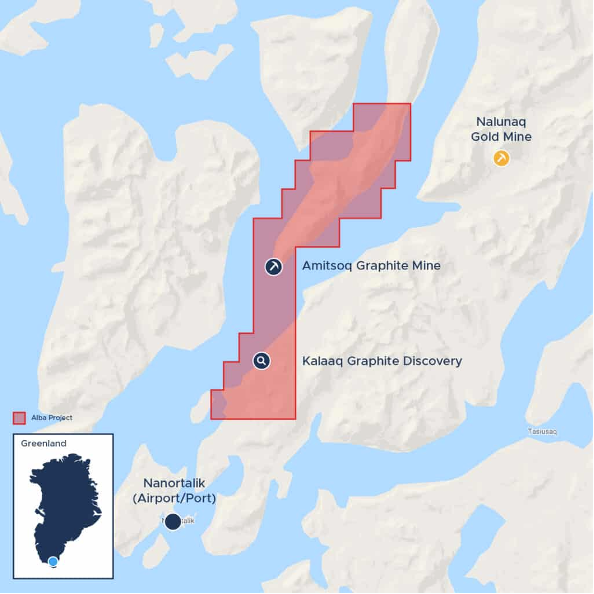
[Source: Company]
In total, five drill pads have been prepared at 100-200m spacing along strike, situated on top of the steep ridge that forms the southern tip of the island.
From each pad, three holes will be drilled with varying dip to intercept the upper and lower graphite horizons at increasing depths.
The proposed hole layout aims to intercept mineralisation over a strike length of approximately 600m.
Drilling will take place on Amitsoq island which is the location of the highest-grade graphite (averaging 28.7% TGC) as well as being the site of a previously producing mine.
Figure 2 shows a photograph of the southern part of Amitsoq Island facing north-west and showing the position of the drillholes on the topography. Figure 3 is a 3D view showing the five drill fences and the projected graphite bodies.
The core will be drilled using triple tube technology to minimise any potential core loss over the graphite intersections.
Obsidian’s field exploration team of geologists and assistants, drill crew and environmental contractors are being accommodated on a chartered vessel anchored close to the drill site for the duration of the programme, which is expected to last for about six weeks.
Helicopter support will be provided to transport equipment to site.
Figure 2: Drill sites (white triangles) at southern end of Amitsoq Island, view towards NW. Outcrops of graphite layers in yellow with mapped faults in red dashed lines
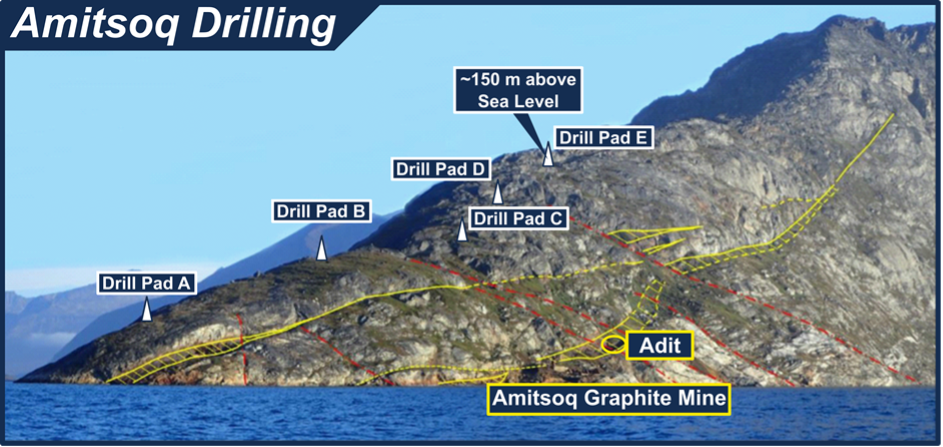 [Source: Company]
[Source: Company]
On 7 June 2021, Alba reported the release of an Exploration Target for the Amitsoq Island deposit, with a range of 1.7-4.5 million tonnes (assuming a density of 2.63t/m3) and a grade range of 24-36% Graphitic Carbon. This drilling programme is designed to provide supporting Resource definition to the Exploration Target.
Figure 3: 3D model of the graphite mineralisation and the drillhole fences.
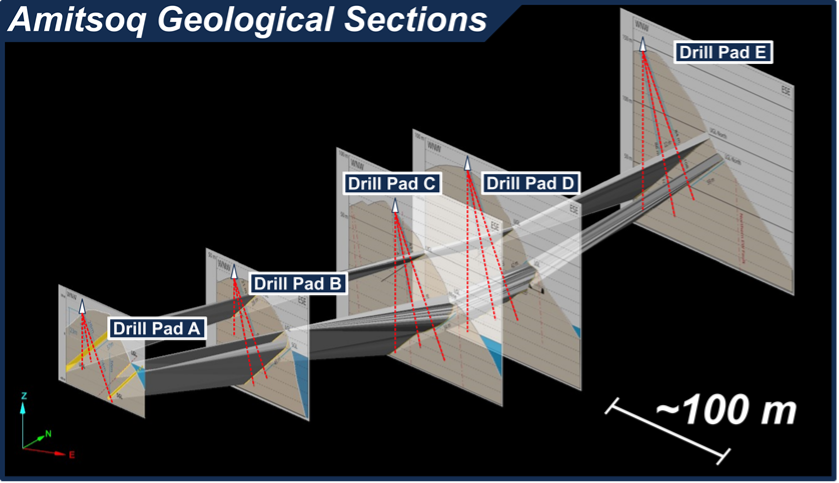
[Source: Company]
Figure 4: Drone image from Amitsoq Island drill site (Drill Pad A) (taken June 2021).
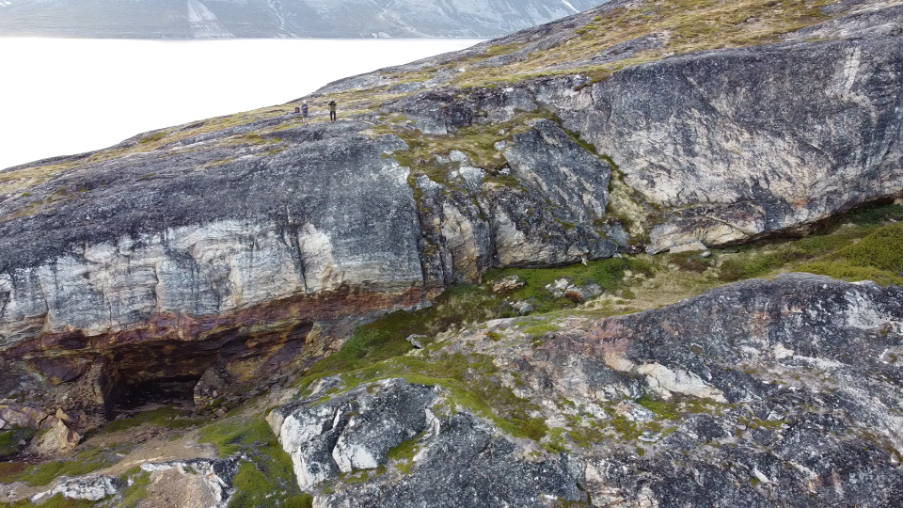
[Source: Company]
Figure 5: Drone image of Amitsoq Island from the south looking north (taken June 2021).

[Source: Company]
Figure 6: Drill Rig and equipment being unloaded to Amitsoq Island. Site of former graphite mine processing equipment on right. (taken 12 June 2021)
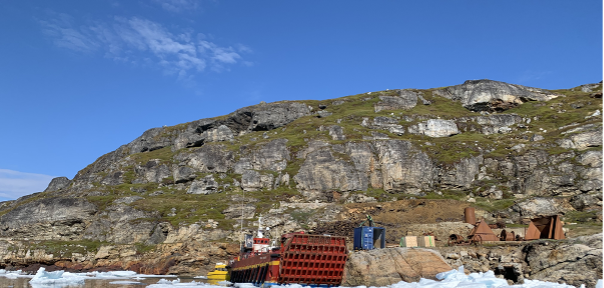
[Source: Company]
Environmental Baseline Studies
Experienced environmental consultants BioApp Greenland will be undertaking an initial environmental baseline screening at Amitsoq during this summer’s field programme.
The survey will focus on gathering an overview of the ecological conditions in the area, supplemented by collecting information on aquatic macro invertebrates, water quality parameters, marine environment, wildlife, and birds in the area.
The collected data will be part of the Project’s environmental baseline data package and contribute to a future environmental impact assessment (“EIA”) for Amitsoq.
The BioApp team have in-depth knowledge and an extensive track record of environmental sampling in all parts of Greenland. The team is multidisciplinary and will cover both freshwater, marine and terrestrial sampling.
Mark Austin, Alba’s Chief Operating Officer, commented: “This is an exciting time for Alba as we move onto the drilling of one of the world’s highest grade graphite deposits. The test work from our extensive field sampling has shown that the target value for the LOI content of 99.9%, and the typical specification for spherical graphite of 99.95%, are both capable of being achieved which qualifies this graphite as battery grade and suitable for the EV market. These results, together with the Exploration Target of 1.7 and 4.5 million tonnes for the Amitsoq Island deposit alone, with a grade range of between 24-36% Graphitic Carbon, gives us great confidence in the project’s fundamentals.”
“The first objective arising out of our drilling programme will be to declare a maiden JORC-compliant Mineral Resource at the Amitsoq Island deposit. Ultimately, our goal is to prove up sufficient tonnes to be able to move to the feasibility study stage as soon as possible thereafter.”
Kalaaq Exploration Programme
In addition, the Company has announced a separate field team will conduct a mapping and sampling programme at the Kalaaq Discovery on the mainland portion of Obsidian’s licence area.
The Kalaaq area contains multiple horizons of graphite mineralisation that are interpreted to have been subject to complex folding.
Individual outcrops expose graphite horizons up to 9m true thickness, however lateral continuity is harder to observe due to surficial sediment cover.
Mapping by Obsidian to date has shown mineralised horizons occur within an area of 1.2 km along strike (north-south) and up to 500m wide.
Average grades from sampling conducted at Kalaaq are 25.6% TGC, also among the highest of any project in the world.
Figure 7: Graphite layer at the Kalaaq Prospect
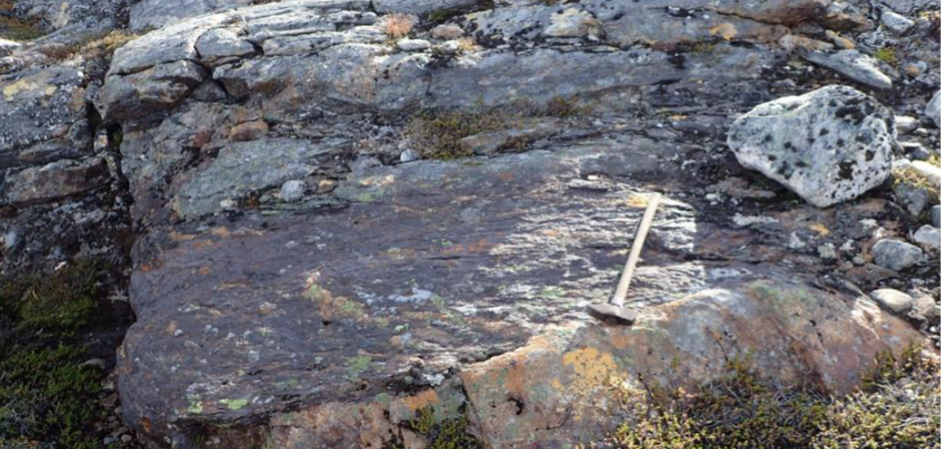
[Source: Company]
This exploration will involve extensive mapping and sampling, including the use of a beep mat to record electromagnetic (EM) conductivity and magnetic susceptibility down to 3 m below surface, through overburden.
Beep Mat traverses, mapping and systematic channel sampling of discoveries is designed to extend the known graphite mineralised structure significantly.
View from VOX
More positive operational progress for ALBA as the Company moves towards establishing a Mineral Resource at Amitsoq. The six-week drilling campaign will provide the foundation for progressing the Project to the development stage with a Scoping Study to assess application of various mining methods, logistics, infrastructure requirements, refinement of the process flowsheet and mine waste management.
In addition, ALBA has delivered further welcome news regarding the mapping and sampling program at the Kalaaq Discovery on the mainland portion of Obsidian’s license area. Investors will recall that on 7 June 2021, Alba reported the release of an Exploration Target for Kalaaq mineralisation alone of between 4.0 and 7.0 million tonnes (assuming a density of 2.63t/m3) with a grade range of between 23-29% Graphitic Carbon following discovery of Graphite deposits during Obsidian’s fieldwork in the summer of 2017.
Shares in Alba are unchanged following the announcement at 0.26p
Reasons to ALBA
Alba Mineral Resources is a well-diversified exploration and development company which owns and operates mining projects in Greenland, Wales, and Ireland. Its strategy is to identify and secure undervalued assets with a diversified commodity mix where there is potential for discovering further unexploited resources alongside the existing mine site.
Limerick Base Metals Project
Historically, only eight drillholes have been completed within Alba’s Project area of the Limerick Base Metals Project, the most recent being the three holes drilled in Q2 of 2019.
Alba said these low levels of drilling are unusual in the Irish context and, for this reason, the area is considered under-explored. Alba has previously identified several attractive targets that have never been drilled before.
Alba’s current technical team, led by Mark Austin, Alba’s COO and Senior Geologist, will undertake a comprehensive review of the licence area before determining the next phase of planned exploration activities.
The expenditure conditions attached to the renewal of PL 3824 require Alba to incur expenditure of €15,732 by 26 May 2021 with a further €50,000 to be spent by 26 May 2022.
JORC Resources expected
Despite losing field time to the COVID-19 pandemic, Alba said it can execute one of the most significant underground work programmes seen for several decades at its Clogau gold mine in Wales, just as the commodity is reaching all-time highs in value.
Alba said its mining projects remain on ‘a sound footing’, with JORC resources at both Thule Black Sands and Melville Bay, and plans to drill a maiden JORC resource at Amitsoq in 2021.
Amitsoq
In recent weeks, Alba said an independent test work programme at the Group’s Amitsoq graphite project in southern Greenland has confirmed ‘very high carbon content.’ Due to the high carbon content, the product would offer ‘a significant advantage, as no purification would be needed to achieve that level,’ the Company explained to investors.
Accordingly, subject to certain follow-up test work which the Group said is recommended, the test work successfully indicates the suitability of Amitsoq graphite as feed material for Lithium-Ion Batteries ("LIBs"), the fastest growing market for flake graphite globally.
‘This finding that the concentrate appears to be suitable for LIBs is significant, as the market for LIBs is the fastest growing market for flake graphite, with massive growth rates forecast for the next decade due to the expected demand for LIBs in electric vehicles,’ Alba outlined.
Transition from Exploration to Production in Greenland and Wales
Other ‘significant’ progress has also been made in recent years towards Alba’s ultimate goal of achieving commercial production at one or more of its sites, including at the Thule Black Sands in Greenland, the Amitsoq project in Greenland and the Horse Hill well in Surrey.
In 2020, Alba announced that surface trenching activities would kick-start over the first of the group’s 10 regional gold targets over the Dolgellau Gold Field.
The trenching will target the first of 10 separate new gold targets over the Dolgellau Gold Field which have previously been identified by Alba.
Alba said up to eight trenches have been planned in this first phase, each varying in length from 40-90m for a total of 575m, with each trench being 1m wide and up to 2m deep.
Once exposed, the quartz veining and other structures from the trenches, those of which are pictured below, will be sampled, and those samples sent to a laboratory for assaying.


